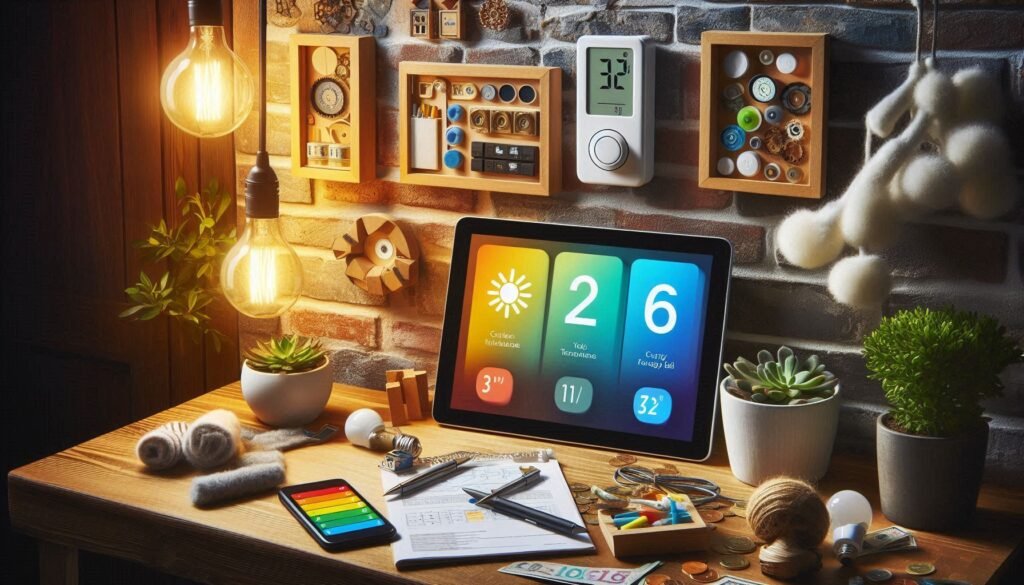Energy bills can be one of the highest monthly expenses, but with a few simple DIY hacks, you can significantly reduce these costs throughout the year. By making your home more energy-efficient, you’ll not only cut down on your utility bills but also contribute to a more sustainable environment. Whether it’s during the hot summer months or the chilly winter season, these easy-to-implement energy-saving hacks can help you save money and enjoy a more comfortable home.

1. Weatherproof Your Doors and Windows
Air leaks through doors and windows are one of the main culprits of energy loss in a home. These leaks allow cold air to seep in during the winter and warm air to escape during the summer. Fortunately, weatherproofing is an inexpensive and easy solution.
How to Weatherproof Your Home:
- Install Weatherstripping: Apply weatherstripping around the edges of doors and windows to create a tight seal.
- Use Draft Stoppers: Place draft stoppers at the bottom of doors to prevent warm or cold air from escaping.
- Seal Window Gaps: Use clear silicone caulk to seal any gaps in windows or door frames.
- Install Window Film: Consider applying reflective window film that can block out heat in the summer and reduce heat loss in the winter.
These simple measures can save you hundreds of dollars each year by keeping your home at a more consistent temperature.
2. Upgrade to Energy-Efficient Light Bulbs
Switching to energy-efficient LED bulbs is one of the easiest and most cost-effective energy-saving hacks you can implement. LED bulbs use up to 80% less energy than traditional incandescent bulbs and last much longer.
Why You Should Make the Switch:
- Energy Savings: LED bulbs consume less electricity and have a lower operating cost.
- Longer Lifespan: An LED bulb can last up to 25 times longer than a regular incandescent bulb.
- Reduced Heat Emission: LEDs emit very little heat compared to incandescent bulbs, which helps keep your home cooler.
If you’re still using incandescent bulbs, making the switch to LEDs can result in substantial savings on your electricity bill.
3. Install a Smart Thermostat
A smart thermostat is one of the best investments you can make to reduce your heating and cooling expenses. Smart thermostats learn your schedule and adjust the temperature automatically, ensuring your home is only heated or cooled when you need it.
Benefits of a Smart Thermostat:
- Energy Savings: Smart thermostats optimize your heating and cooling cycles, reducing wasted energy.
- Remote Control: You can control the temperature from your phone, making it easy to adjust the thermostat even when you’re away.
- Programmable Schedules: Set custom schedules to heat or cool your home only when needed, rather than running the system constantly.
By installing a smart thermostat, you can expect to save up to 10-15% on your heating and cooling bills annually.
4. Insulate Your Home
Proper insulation is crucial to keeping your home energy-efficient. Without adequate insulation, your heating and cooling systems will work harder to maintain a comfortable temperature, driving up energy costs.
Key Areas to Insulate:
- Attic: Heat rises, so a poorly insulated attic can be a major source of energy loss. Add insulation to your attic to reduce heating costs in the winter and cooling costs in the summer.
- Basement: Insulate basement walls to keep your home warm in the winter and cool in the summer.
- Exterior Walls: If your home has poor insulation in its walls, consider adding insulation in the form of spray foam or fiberglass batt insulation.
Investing in proper insulation can have a significant long-term impact on your energy bills, as well-insulated homes stay warmer in winter and cooler in summer.
5. Unplug Electronics When Not in Use
Did you know that many electronic devices consume power even when they’re turned off? This phenomenon is known as “phantom power” or “standby power,” and it can account for up to 10% of your electricity bill.
How to Combat Phantom Power:
- Unplug Devices: Simply unplugging electronics when they’re not in use, such as chargers, televisions, and computers, can save you money.
- Use Power Strips: Plug multiple devices into power strips and turn them off when not in use to prevent standby power from draining energy.
- Smart Plugs: Invest in smart plugs that can automatically turn off electronics when not in use.
By reducing phantom power consumption, you can make a noticeable dent in your electricity bill without changing your daily habits.
6. Switch to Energy-Efficient Appliances
When it’s time to replace old appliances, consider upgrading to energy-efficient models. Many modern appliances come with Energy Star ratings, indicating that they meet certain energy efficiency standards.
Energy-Efficient Appliances to Look For:
- Refrigerators: Choose an Energy Star-rated refrigerator that uses less energy and runs more efficiently.
- Washing Machines and Dishwashers: Newer models of washing machines and dishwashers are designed to use less water and energy, reducing your utility bills.
- Air Conditioners and Heaters: Upgrade to an energy-efficient HVAC system that uses less power to heat and cool your home.
While these appliances might have a higher upfront cost, they pay for themselves over time through reduced energy consumption.
7. Seal Your Ducts
Leaky ducts can account for a significant loss of energy, as air escapes through cracks and gaps, making your heating and cooling systems work harder. Sealing your ducts is a simple yet effective way to improve energy efficiency.
How to Seal Ducts:
- Inspect for Leaks: Check your ducts for visible gaps or cracks. You can do this by turning on your heating or cooling system and feeling around the ductwork for air leaks.
- Seal with Mastic or Foil Tape: Use mastic (a thick paste) or foil tape to seal any gaps you find.
- Consider Duct Insulation: If you have exposed ducts, insulating them can help reduce energy loss.
Sealing your ducts can increase the efficiency of your heating and cooling systems and lower your energy bills.
8. Reduce Hot Water Usage
Water heating accounts for a significant portion of household energy consumption, but there are several ways to reduce hot water usage without sacrificing comfort.
Ways to Reduce Hot Water Usage:
- Install a Low-Flow Showerhead: Low-flow showerheads use less water and reduce the energy required to heat water.
- Take Shorter Showers: Reducing your shower time by just a few minutes can significantly lower water heating costs.
- Use Cold Water for Laundry: Washing clothes in cold water rather than hot can reduce the amount of energy needed to heat water for laundry.
These small changes can help you reduce your energy consumption while still enjoying a comfortable home.
9. Opt for Energy-Efficient Landscaping
Energy-efficient landscaping, also known as “xeriscaping,” can help reduce your home’s energy use by providing natural insulation and shade.
Landscaping Tips:
- Plant Trees Strategically: Planting trees on the south and west sides of your home can provide shade in the summer, reducing the need for air conditioning.
- Use Mulch: Applying mulch around plants and trees helps retain moisture, reducing the need for excessive watering and cooling systems.
- Create Windbreaks: Planting shrubs or trees to block cold winds during the winter can reduce heating costs.
Energy-efficient landscaping is an eco-friendly way to keep your home cooler in the summer and warmer in the winter, saving you money in the process.
10. Maintain Your HVAC System
Proper maintenance of your HVAC system is essential for ensuring it operates efficiently. A well-maintained HVAC system uses less energy to heat or cool your home.
HVAC Maintenance Tips:
- Change the Air Filters: Regularly replace the air filters in your HVAC system to maintain airflow and prevent strain on the system.
- Schedule Annual Inspections: Hire a professional to inspect and maintain your heating and cooling system annually. This can help identify potential issues before they become costly repairs.
- Clean the Vents: Dust and debris can block air vents, causing your HVAC system to work harder. Keep vents clean and free of obstructions to ensure optimal performance.
Regular HVAC maintenance will improve energy efficiency and extend the lifespan of your system.
Conclusion:
By implementing these DIY energy-saving hacks, you can cut your utility bills year-round while reducing your environmental impact. Whether it’s weatherproofing doors, upgrading light bulbs, or optimizing your HVAC system, every small change adds up to significant savings over time. Start with a few simple changes, and soon you’ll be enjoying a more energy-efficient home that doesn’t break the bank.
Call to Action:
LEARN POWERFUL DIGITAL SKILLS. ATTEND FREE MASTERCLASS NOW!
Click here to join the masterclass!
Related Blog Posts
10 Budget-Friendly Room Makeover
How to Organize Your Home Like a Pro
15 Creative Storage Solutions for Small Spaces
A Beginner’s Guide to Painting a Room
How to Create a Cozy Home Office
Simple DIY Landscaping Projects
10 Must-Know Tips for Organizing Your Kitchen










